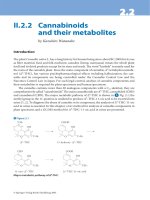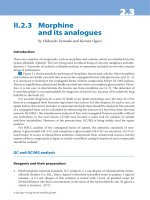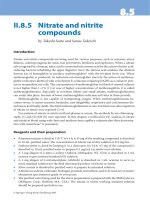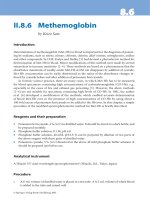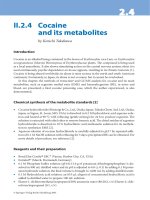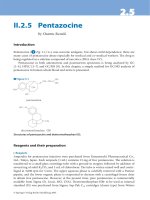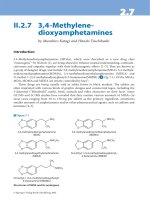Drugs and Poisons in Humans - A Handbook of Practical Analysis (Part 25)
Bạn đang xem bản rút gọn của tài liệu. Xem và tải ngay bản đầy đủ của tài liệu tại đây (503.43 KB, 11 trang )
2.72.7
© Springer-Verlag Berlin Heidelberg 2005
II.2.7 3,4-Methylene-
dioxyamphetamines
by Munehiro Katagi and Hitoshi Tsuchihashi
Introduction
3,4-Methylenedioxyamphetamines (MDAs), which were described as a new drug class
“ entactogens”
a
by Nichols [1], are being abused to enhance mutual understanding, communi-
cativeness and empathy together with their hallucinogenic e ects [1–3]. ey are known as
a group of designer drugs, and include 3,4-methylenedioxyamphetamine(MDA), 3,4-methyle-
nedioxymethamphetamine( MDMA), 3,4-methylenedioxyethylamphetamine ( MDEA) and
N-methyl-1-(3,4-methylenedioxyphenyl)-2-butanamine( MBDB) (
> Fig. 7.1). Of the MDAs,
MDA, MDMA and MDEA are strictly controlled by laws
b
.
ese drugs are being usually sold in tablet forms in black markets. e tablets are
o en imprinted with various kinds of graphic designs and commercial logos, including the
3-diamond (“Mitsubishi” mark), birds, animals and other characters on their faces. Some
GC/MS and LC/MS studies have revealed that they contain various amounts of MDAs (in
most cases ranging from 50 to 150 mg per tablet) as the primary ingredient, sometimes
smaller amounts of amphetamines and/or other pharmaceutical agents, such as ca eine and
ketamine [4, 5].
Structures of MDA and its analogues.
⊡ Figure 7.1
230 3,4-Methylene dioxyamphetamines
MDMA, which is well known by the street name of “ Ecstasy”, is now the most popular
recreational drug in the world. It emerged in Europe in the 1980s and has generally been being
used at all night techno dance parties ( Raves). It is also becoming more popular in the United
States and even in Japan.
Several studies have shown that MDMA is metabolized mainly by demethylenation,
O-methylation, N-demethylation and conjugation as shown in
> Fig. 7.2 [6–10]. For the
proof of MDMA use, detection of MDMA and its metabolite MDA is being generally per-
formed for urine specimens.
In this chapter, the procedures for GC/MS and LC/MS analyses of MDAs in the forms of
tablets and those for GC/MS analysis of MDAs and their main metabolites 4-hydroxy-3-me-
thoxymethamphetamine ( HMMA) and 4-hydroxy-3-methoxyamphetamine ( HMA) in urine
specimens are presented.
Metabolic pathways for MDMA and MDA.
⊡ Figure 7.2
231
Reagents and their preparation
• MDA, MDMA and MDEA can be purchased from Sigma (St. Louis, MO, USA) with ap-
propriate legal procedures. ey can be also synthesized by reductive amination of pipero-
nyl methyl ketone (Tokyo Kasei Kogyo Co., Ltd., Tokyo, Japan) using ammonium acetate
or appropriate amines (Sigma and other manufacturers) and sodium cyanoborohydride
(Aldrich, Milwaukee, WI, USA); every synthesized standard compound is puri ed as their
hydrochloride. e standard stock solutions are prepared in distilled water (1 mg/mL), and
diluted to appropriate concentrations with drug-free urine.
• Acetonitrile is of HPLC grade, and other chemicals used are of analytical grade.
• Samprep-LCR unit, a 0.2 µm plastic membrane lter, is purchased from Millipore (Bed-
ford, MA, USA).
• HMMA is synthesized by the reaction of methylamine hydrochloride and sodium cyano-
borohydride with 4-hydroxy-3-methoxyphenylacetone (Aldrich) [11]. HMA is synthesized
by the reduction of 4-hydroxy-3-methoxyphenyl- 2-nitropropene, which has been prepared
by reaction of 4-hydroxy-3-methoxybenzaldehyde (Aldrich) with nitroethane (Aldrich)
[11]. Every synthesized standard was puri ed as each hydrochloride. e standard stock
solutions are prepared with distilled water (1 mg/mL), and diluted to appropriate concen-
trations with drug-free urine.
• Diphenylmethane (DPM, obtainable from many manufacturers) solution is prepared by
dissolving 1 mg DPM in 100 mL ethyl acetate, and used as internal standard (IS) solution
for quantitation.
• Carbonate bu er solution (pH 10) is prepared by dissolving 2.1 g of NaHCO
3
and 7.9 g of
anhydrous Na
2
CO
3
in 100 mL distilled water.
• β-Glucuronidase (from E. coli, type IX-A) used for hydrolysis is purchased from Sigma.
• Bond Elut SCX (100 mg) cation-exchange cartridges used for solid-phase extraction are
purchased from Varian (Harbor City, CA, USA).
Instrumental conditions
a)
GC/MS
Instrument: Shimadzu GCMS-QP2010 (Shimadzu, Kyoto, Japan); columns: DB-1 and DB-17 MS
fused-silica medium-bore capillary columns (both 30 m × 0.32 mm i. d., lm thickness 0.25 µm,
J&W Scienti c, Folsom, CA, USA); injection mode: splitless; injection temperature: 250 °C;
column temperature: 70 °C (1 min)→15 °C/min→300 °C (5 min); temperatures of the interface
and the ion source: 250 and 200 °C, respectively; carrier gas: He; its ow rate: 3 mL/min; EI elec-
tron energy: 70 eV; multiplier gain, 1.2; scan range: m/z 40–400; scan rate: 0.5 s/scan.
b)
LC/MS
Instrument: Shimadzu LCMS-QP2010; column: CAPCELL PAK SCX (150 × 1.5 mm i. d.,
Shiseido, Tokyo, Japan)
c
; mobile phase: acetonitrile/10 mM ammonium acetate (70:30, v/v,
pH 5.5); ow rate: 150 µL/min; interface: electrospray ionization (ESI); capillary voltage:
3,4-Methylenedioxyamphetamines
232 3,4-Methylene dioxyamphetamines
+ 3.5 kV; probe voltage: 2.5 kV; CDL voltage: –20 V; CDL temperature: 230 °C; de ector volt-
age: 40 V; multiplier voltage: 650 V; quantitative analysis: by the absolute calibration curve
method employing the protonated molecule of each analyte in the selected ion monitoring
(SIM) mode
d
.
Procedures
a) Tablet specimens
i. For GC/MS analysis
i. A sample tablet is ground into ne powder. A 10-mg aliquot of it is dissolved in 10 mL of
distilled water.
ii. e solution is extracted with 20 mL of ethyl acetate under ammonia-alkaline conditions
(pH 9).
iii. e organic layer is dried with anhydrous sodium sulfate, and evaporated to dryness under
a stream of nitrogen a er adding 10 µL of 2.5 M HCl solution.
iv. To the residue is added 0.2 mL of tri uoroacetic anhydride and 0.2 mL of ethyl acetate, and
the mixture is heated at 60 °C for 30 min
e
.
v. e reaction mixture is evaporated to dryness under a gentle stream of nitrogen and recon-
stituted in 100 µL of DPM (IS) solution. A 1-µL aliquot of it is injected into GC/MS.
ii. For LC/MS analysis
i. A sample tablet is ground and dissolved in distilled water as described above.
ii. e aqueous solution is further diluted to appropriate concentrations with distilled water.
e resulting sample aqueous solution is passed through a Samprep-LCR unit, a 0.2 µm
plastic membrane lter
f
.
iii. A 5-µL aliquot of the ltrate is injected into LC/MS.
b) Urine specimens for MDAs and their metabolites
i. Hydrolysis
Enzymatic hydrolysis:
To 2 mL of urine is added 0.4 mL of 75 mM phosphate bu er (pH 6.8), containing 2000
Fishman units/mL urine of β-glucuronidase
g
. e mixture is incubated at 37 °C for 3 h. A er
centrifugation, the supernatant solution is subjected to the below extraction procedure.
Acid hydrolysis
h
:
To 2 mL of urine is added 0.5 mL of conc. HCl, and the mixture is heated at 100 °C for 1 h.
A er cooling to room temperature, the mixture is neutralized with solid Na
2
CO
3
. e solution
is subjected to the below extraction procedure.
ii. Extraction
Liquid-liquid extraction:
i. e above hydrolyzed solution is mixed with 2 mL of carbonate bu er solution (pH 10)
i
and extracted with 5 mL of chloroform/isopropanol (3:1, v/v).
233
ii. A er centrifugation, the organic layer is separated and dried with anhydrous sodium sul-
fate.
iii. It is transferred to a screw-capped Pyrex tube and evaporated to dryness under a stream of
nitrogen a er adding 10 µL of 2.5 M HCl solution. e residue is subjected to the below
tri uoroacetyl (TFA)-derivatization.
Solid-phase extraction [6]:
i. A Bond Elut SCX cartridge is successively preconditioned with 2 mL of methanol, 1 mL of
distilled water and 1 mL of 25 mM KH
2
PO
4
solution.
ii. e hydrolyzed urine sample is mixed with 1 mL of 75 mM KH
2
PO
4
solution and loaded
on the preconditioned cartridge.
iii. e cartridge is washed with 1.5 mL of 25 mM KH
2
PO
4
and then 1 mL of methanol.
iv. Target compounds are eluted with 2 mL of methanol/2.5 M HCl solution (97.5:2.5, v/v).
v. e eluate is transferred to a screw-capped Pyrex tube and evaporated to dryness under a
stream of nitrogen. e residue is subjected to the below TFA-derivatization.
iii. Derivatization
i. To the extract residue are added 0.2 mL of tri uoroacetic anhydride
j
(TFAA) and 0.2 mL
of ethyl acetate, and the mixture is heated at 60 °C for 30 min.
ii. e reaction mixture is evaporated to dryness under a gentle stream of nitrogen and recon-
stituted in 0.1 mL of DPM (IS) solution. A 1-µL aliquot of it is injected into the GC/MS
system with a DB-17MS system
k
.
Assessment of the methods
EI mass spectra of TFA derivatives
l
of MDA, MDMA and MDEA, obtained from clandestine
tablets, are shown in
> Fig. 7.3. e MDAs produce EI mass spectra characterized by intense
ions resulting from the α-cleavage of the amines and some less intense fragment ions.
Recently, MBDB and an MDMA homologue, N-methyl-1-(3,4-methylenedioxyphemyl)-
3-butanamine ( HMDMA) (
> Fig. 7.1), have appeared as components of clandestine drug
samples even in Japan. MBDB and HMDMA are regioisomers of MDEA [9]; MBDB yields a
very similar EI mass spectrum to that of MDEA. e discrimination of these isomers can be
accomplished by proton nuclear magnetic resonance spectrometry, but it is useless for small
amounts of the compounds in a tablet mixture. As an alternative technique for such isomer
discrimination, TFA derivatization followed by GC/MS is applicable (
> Fig. 7.3).
e quantitative analysis data for MDAs in many kinds of clandestine tablets encountered
in Japan are summarized in
> Table 7.1 [4, 5]. For simple and rapid quantitation, the LC/MS
technique without any derivatization would be more recommendable.
A total ion chromatogram and mass chromatograms obtained from an MDMA addict’s
urine by the GC/MS technique a er the liquid-liquid extraction are shown in
> Fig. 7.4. Not
only MDMA and its metabolite MDA, but also their metabolites with open methylenedioxy
rings, HMMA and HMA, were detected in the urine sample (HHMA not monitored). e
mass spectra of TFA derivatives of MDMA and its three metabolites obtained from the urine
specimen are shown in
> Fig. 7.5.
For the proof of the use of MDMA, detection of MDA along with MDMA itself is being
usually performed [12–14]. However, the main metabolic pathway of MDMA in humans is the
3,4-Methylenedioxyamphetamines


